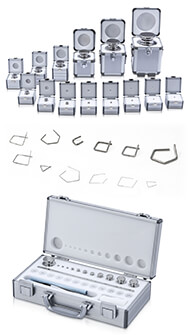Minimum accuracy class for weights
The accuracy class for weights used as standards for the calibration of weights or scales must meet the requirements of the relevant OIML recommendations.
OIML R 111-1:2004 is a recognised technical rule and was adopted by the International Conference of Legal Metrology in 2004. In addition, weights are used to trace other physical units of measurement and are also used in metrology that is not regulated by law. . OIML R 111:1994 was replaced by DIN 8127:2007-11.
The OIML accuracy classes of weights are defined as follows:
Class E1: Test and calibration weights for the calibration and quality assurance of scales with a number of steps > 1 000 000
Weights to ensure traceability between the national mass standards (whose values are derived from the International Prototype of the Kilogram) and the weights of class E2 and lower. Class E1 weights or weight sets must always be accompanied by a calibration certificate.
Class E2: Test and calibration weights for the calibration of precision scales (Accuracy Class I) with a number of steps < 1 000 000
Weights for the verification or calibration of class F1 weights. Class E2 weights or weight sets must be accompanied by a calibration certificate. They can be used as class E1 weights if they meet the requirements for surface roughness, magnetic susceptibility and magnetisation for class E1 weights and this data is specified in the calibration certificate.
Class F1: Adjustment, test and calibration instrument for commercial scales (Accuracy Class I and II) with a number of steps < 300 000
Weights for the verification or calibration of class F2 weights.
Class F2: Adjustment, test and calibration instrument for commercial scales (Accuracy Class II) with a number of steps < 100 000
Weights for the verification or calibration of class M1 weights and possible class M2 ones.
Also for use in major commercial transactions (e.g. precious metals or stones) with Accuracy Class II scales.
Class M1: Calibration weights as a calibration instrument for commercial scales (Accuracy Class III) with a number of steps < 30 000
Weights for the verification or calibration of class M2 weights, and weights for use with class III scales.
Class M2: Test weights for testing of weights for commercial scales (class III) with a number of steps < 10 000
Weights for the verification or calibration of class M3 weights as well as weights for use with class III scales in general commercial transactions.
Class M3: Commercial weights as a test instrument for commercial scales (Accuracy Class III and IIII) with a number of steps < 3 000
What is a “weight set” exactly?
A weight set, that is a set of weights, is an assembly of a group or series of weights of the same accuracy class that have similar metrological characteristics. These are each housed in a box, case or crate in an organised fashion. With the weight set, it’s possible to weigh all loads from the weight of the weight with the smallest nominal value up to the sum of all the weights in a container. The weight with the smallest nominal value determines the gradation of the weights.
* The nominal value designations used in the table for the weights refer to the smallest and largest weight permitted in a class according to R 111, and the error margins and designations cannot be extrapolated to higher or lower values. For instance, the smallest nominal value for a weight in class M2 is 100 mg, while the largest is 5000 kg. A 50 mg weight would not be accepted as an M2 class weight under R 111, but would have to comply with the error margins and other requirements of class M1 (e.g.: shape or markings). Otherwise the weight would not be in conformity with R 111.
Error margins for weights – error margin classes
The error margin of a weight corresponds to the permissible tolerance, i.e. the largest permissible deviation from the nominal value in a positive or negative direction. The error margin classes of weights are devised in a strictly hierarchical system and defined in the OIML.
Based on this system, E1 is defined as the most accurate and M3 the weight class with the highest measurement uncertainty.






